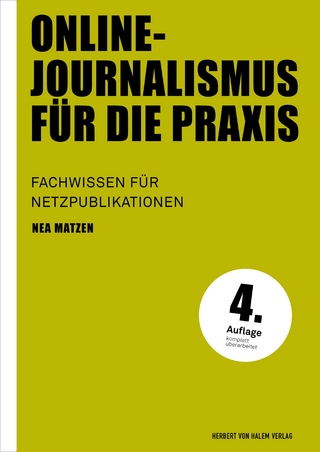
Everyday Media Literacy
Routledge (Verlag)
978-1-032-15661-3 (ISBN)
The textbook applies media literacy principles and critical thinking to the key issues facing young adults today, from analyzing and creating media messages to verifying information and understanding online privacy. Through discussion prompts, writing exercises, key terms, and links, readers are provided with a framework from which to critically consume and create media in their everyday lives. This new edition includes updates covering privacy aspects of AI, VR and the metaverse, and a new chapter on digital audiences, gaming, and the creative and often unpaid labor of social media and influencers. Chapters examine news literacy, online activism, digital inequality, social media and identity, and global media corporations, giving readers a nuanced understanding of the key concepts at the core of media literacy. Concise, creative, and curated, this book highlights the cultural, political, and economic dynamics of media in contemporary society, and how consumers can mindfully navigate their daily media use.
This textbook is perfect for students and educators of media literacy, journalism, and education looking to build their understanding in an engaging way.
Sue Ellen Christian is the Western Michigan University Presidential Innovation Professor in Communication (2021–2024). An author and former Chicago Tribune journalist, her past awards include Michigan Professor of the Year and WMU’s Distinguished Teaching Award. She is guest curator of Wonder Media: Ask the Questions!, an interactive museum exhibition focusing on news literacy and media literacy and the author of Overcoming Bias: A Journalist’s Guide to Culture and Context (2021).
Introduction: Why media literacy and why you 1. Using: How your time with media can be more intentional 2. Spending: How the big, big business of media affects you and where you can profit 3. Thinking: How to protect your daily allotment of attention 4. Informing: How news media seek truth and shape reality 5. Verifying: How to find a fact and know when you’ve found one 6. Selling: How audiences are bought and sold and your role in the transaction 7. Analyzing: How media messages deliver meaning through content and creativity 8. Connecting: How media communicates culture and how cultures respond 9. Creating: How to create messages with purpose, expression and ethics 10. Protecting: How technology invades your privacy and how to protect it 11. Choosing: How to curate your media use to positively shape your sense of self 12. Participating: How technology supports and challenges civic engagement and democracy
| Erscheinungsdatum | 19.10.2023 |
|---|---|
| Zusatzinfo | 3 Halftones, color; 27 Halftones, black and white; 3 Illustrations, color; 27 Illustrations, black and white |
| Verlagsort | London |
| Sprache | englisch |
| Maße | 152 x 229 mm |
| Gewicht | 489 g |
| Themenwelt | Geisteswissenschaften ► Geschichte |
| Sozialwissenschaften ► Kommunikation / Medien ► Journalistik | |
| Sozialwissenschaften ► Kommunikation / Medien ► Medienwissenschaft | |
| ISBN-10 | 1-032-15661-9 / 1032156619 |
| ISBN-13 | 978-1-032-15661-3 / 9781032156613 |
| Zustand | Neuware |
| Informationen gemäß Produktsicherheitsverordnung (GPSR) | |
| Haben Sie eine Frage zum Produkt? |
aus dem Bereich


